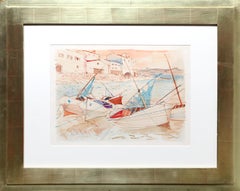Landscape Drawings and Watercolors
2010s Post-Impressionist Landscape Drawings and Watercolors
Color Pencil, Synthetic Paper
1960s Fauvist Landscape Drawings and Watercolors
Watercolor
1940s American Modern Landscape Drawings and Watercolors
Paper, Watercolor
20th Century American Modern Landscape Drawings and Watercolors
Watercolor, Archival Paper
21st Century and Contemporary Fauvist Landscape Drawings and Watercolors
Paper, Pastel, Watercolor, Pencil
1890s Post-Impressionist Landscape Drawings and Watercolors
Pencil, Paper
19th Century Post-Impressionist Landscape Drawings and Watercolors
Watercolor, Paper
Early 1900s Pointillist Landscape Drawings and Watercolors
Oil, Canvas
1930s Post-Impressionist Landscape Drawings and Watercolors
Ink, Paper, Watercolor, Pencil
20th Century American Modern Landscape Drawings and Watercolors
Pencil, Watercolor
1980s Fauvist Landscape Drawings and Watercolors
Paper, Watercolor
1990s Post-Impressionist Landscape Drawings and Watercolors
Oil Pastel, Paper
Late 20th Century American Modern Landscape Drawings and Watercolors
Watercolor, Paper
21st Century and Contemporary Fauvist Landscape Drawings and Watercolors
Paper, Pastel, Watercolor
Mid-20th Century American Modern Landscape Drawings and Watercolors
Paper, Crayon
Early 1900s Post-Impressionist Landscape Drawings and Watercolors
Paper, Watercolor
21st Century and Contemporary Fauvist Landscape Drawings and Watercolors
Paper, Pastel, Watercolor
1930s American Modern Landscape Drawings and Watercolors
Gouache, Paper, Watercolor, Ink
1930s American Modern Landscape Drawings and Watercolors
Paper, Pastel
1980s American Modern Landscape Drawings and Watercolors
Watercolor, Paper
1940s American Modern Landscape Drawings and Watercolors
Paper, Watercolor
Early 20th Century Post-Impressionist Landscape Drawings and Watercolors
Watercolor, Pencil, Paper
1990s Post-Impressionist Landscape Drawings and Watercolors
Pastel
1920s Post-Impressionist Landscape Drawings and Watercolors
Watercolor, Archival Paper
1890s Post-Impressionist Landscape Drawings and Watercolors
Paper, Watercolor
1940s American Modern Landscape Drawings and Watercolors
Watercolor, Paper
Late 20th Century Post-Impressionist Landscape Drawings and Watercolors
Pastel, Paper
1930s American Modern Landscape Drawings and Watercolors
Paper, Pastel
1950s American Modern Landscape Drawings and Watercolors
Graphite, Watercolor
1950s Post-Impressionist Landscape Drawings and Watercolors
Watercolor, Paper
1920s American Modern Landscape Drawings and Watercolors
Paper, Watercolor
1920s American Modern Landscape Drawings and Watercolors
Watercolor
1930s American Modern Landscape Drawings and Watercolors
Ink, Archival Paper
1960s Post-Impressionist Landscape Drawings and Watercolors
Watercolor
Early 1900s Post-Impressionist Landscape Drawings and Watercolors
Paper, Watercolor, Pencil
Mid-20th Century Post-Impressionist Landscape Drawings and Watercolors
Wax Crayon
1940s American Modern Landscape Drawings and Watercolors
Watercolor, Archival Paper
1930s Post-Impressionist Landscape Drawings and Watercolors
Watercolor
1920s American Modern Landscape Drawings and Watercolors
Watercolor
20th Century American Modern Landscape Drawings and Watercolors
Watercolor, Archival Paper
1920s Post-Impressionist Landscape Drawings and Watercolors
Gouache, Archival Paper, Watercolor
1920s American Modern Landscape Drawings and Watercolors
Laid Paper, Watercolor
1920s Post-Impressionist Landscape Drawings and Watercolors
Ink, Crayon, Watercolor
1920s American Modern Landscape Drawings and Watercolors
Watercolor
1920s American Modern Landscape Drawings and Watercolors
Watercolor
2010s American Modern Landscape Drawings and Watercolors
Ink
2010s American Modern Landscape Drawings and Watercolors
Ink
1960s Fauvist Landscape Drawings and Watercolors
Watercolor
1930s American Modern Landscape Drawings and Watercolors
Paper, Watercolor, Pencil
1910s American Modern Landscape Drawings and Watercolors
Watercolor, Gouache
20th Century American Modern Landscape Drawings and Watercolors
Watercolor, Archival Paper
20th Century Post-Impressionist Landscape Drawings and Watercolors
Watercolor, Ink
1990s American Modern Landscape Drawings and Watercolors
Pastel, Rag Paper
1950s American Modern Landscape Drawings and Watercolors
Watercolor
Mid-20th Century American Modern Landscape Drawings and Watercolors
Watercolor
20th Century Post-Impressionist Landscape Drawings and Watercolors
Paper, Pastel
1960s Post-Impressionist Landscape Drawings and Watercolors
Watercolor, Board, Pencil
1970s American Modern Landscape Drawings and Watercolors
Pastel
Shop Landscape Drawings and Watercolor Paintings
Landscape drawings and watercolors show the world through the lenses of different cultures and perspectives. They were also incredibly important for displaying natural scenes before the invention of photography.
There are many ways to effectively arrange art on your walls so that you’re maximizing your wall space. You can introduce peace and serenity within the confines of a living room or bedroom if landscape drawings and watercolors are part of the art that you choose to bring into a space.
Watercolor landscapes have a rich history dating back to ancient China, where they dominated painting genres by the late Tang dynasty. Ink-on-silk paintings in China featured mountains and large bodies of water as far back as the third century. The Netherlands was home to landscapes as a major theme in painting as early as the 1500s, and by the Renaissance, watercolors had made their way to the West and into European culture, becoming a staple of decorative art.
It wasn’t until the Industrial Revolution that watercolor paints became more widely available and embedded in fine arts. Despite their broad distribution today, some artists have chosen to revive the old craft of preparing their own watercolor pigments, paying homage to the medium’s roots.
The variety of brush combinations and painting methods makes watercolor landscapes some of the most stunning pieces in any collection. Find landscape drawings and watercolors on 1stDibs.





